Devils Tower National Monument |
|

Devils Tower National Monument is located in northeastern
Wyoming, in beautiful Crook County. The Tower and the surrounding 1,347
acres were designated as our nation's first National Monument by President
Teddy Roosevelt in 1906. Scientists believe that Devils Tower is the
core of a volcano exposed after millions of years of erosion caused
by weather and the Belle Fourche River. (The Belle Fourche River meanders
around the base of the tower, 1,267 feet below the summit.) While the
name of Devils Tower may not be a household word, millions will recognize
the shape of the Tower from the movie Close Encounters of the Third
Kind, which featured the the Tower as the landing spot for the awesome
Mother Ship.
Devils Tower is a favorite destination for climbers, hikers,
and families, with over 450,000 visitors annually. Kids and adults alike
can enjoy deer and antelope in their natural habitat, and kids of all
ages love the praire dog town. Miles of walking trails offer breath-taking
and ever-changing views of the Tower and the beautiful flora and fauna
that surround it. Annual programs draw visitors from around the world,
and help enrich the experience of visiting America's first national
monument.
The visitors center located at the base of the tower is at an elevation
of 4,250 feet above sea level. The tower itself rises 865 feet above
this point, literally towering above peaceful pines and a boulder field
created over millenia by columns that have fallen and broken into pieces.
Devils Tower is situated just 9 miles south of Hulett, Wyoming, 24
miles west of Aladdin, Wyoming, and 27 miles northwest of Sundance,
Wyoming.
Becoming America's First National Monument
As you walk around Devils Tower, you are struck by the unique geological
attributes it possesses. These attributes led early lawmakers to try
to preserve the tower for enjoyment by all. In 1892 Wyoming Senator
Francis E. Warren persuaded the US General Land Office to create a timber
reserve surrounding the tower. Senator Warren also launched an unsuccessful
effort to declare the entire area a national park. In 1906 Congress
passed the Antiquities Act which empowered the President to bestow national
monument status upon federally owned lands that contain historic landmarks,
historic or prehistoric structures, and other significant historic or
scientific objects. President Theodore Roosevelt quickly invoked the
Antiquities Act, designating Devils Tower the nation's first national
monument on September 24, 1906. The National Park Service was created
in 1916 and evenually assumed administrative control of all national
monuments, including Devils Tower.
Climbing the Tower
On July 4, 1893, amid fanfare and more than 1,000 spectators, William
Rogers and Willard Ripley became the first recognized climbers to make
it to the top of Devils Tower, using a home-made wooden ladder for a
portion of the ascent. The timing of the climb (Independence Day) and
the fact that there was a flag pole at the top of the Tower already,
awaiting the climbers, suggested that perhaps someone had actually scaled
the tower a few days earlier. Meeting at the Tower for Independence
Day became an annual event for area ranchers and their families. At
the third annual picnic (in 1895) Mrs. Rogers used her husband's ladder
to become the first woman to scale the Tower.
Formal records of Tower climbs have been kept since 1937. A climbing
Mecca, more than 5,000 climbers from all over the world arrive at the
Tower each year. There are currently more than 200 routes identified
for use in scaling the massive columns of the Tower.
Recently, the National Park Service has created a set of climbing guidelines
that seeks to limit Tower climbing during the month of June. While climbing
is not banned, the guidelines seek to respect the beliefs of native
peoples who may have a reverence for the tower. For more information
on the guidelines, see the National Park Service's Climbing Management
Plan.
Native American Traditions
The name Devils Tower was first affixed to the Tower in 1875 by a scientific
team escorted by Colonel Richard I. Dodge. The explorer was sent to
this area to look for gold, even though their presence was a violation
of Indian treaty rights. General George Armstrong Custer had recently
confirmed gold reports to the east (in the Black Hills of today's South
Dakota), and unfortunately gold fever seemed to be a common rationalization
for breaking treaties.
Dodge took the name Devils Tower as a literal translation of "Bad
God's Tower," which was one name which Indians used for the area.
This name reflected the fear which many Native Americans felt for the
area. Mateo Tepee, or "Bear Lodge," is the common Native American
name used for the Tower today, although it is by no means the only name.
Different tribes, utilizing different languages, have different names
for this unique geologic formation. |